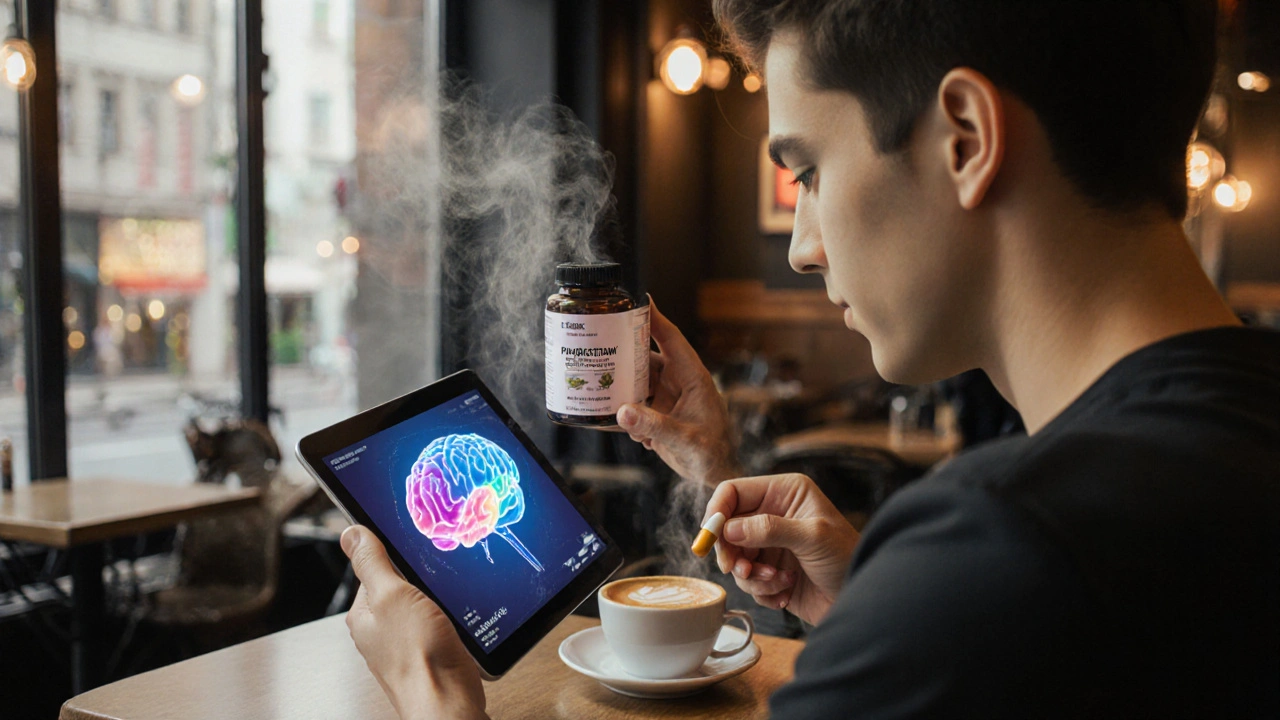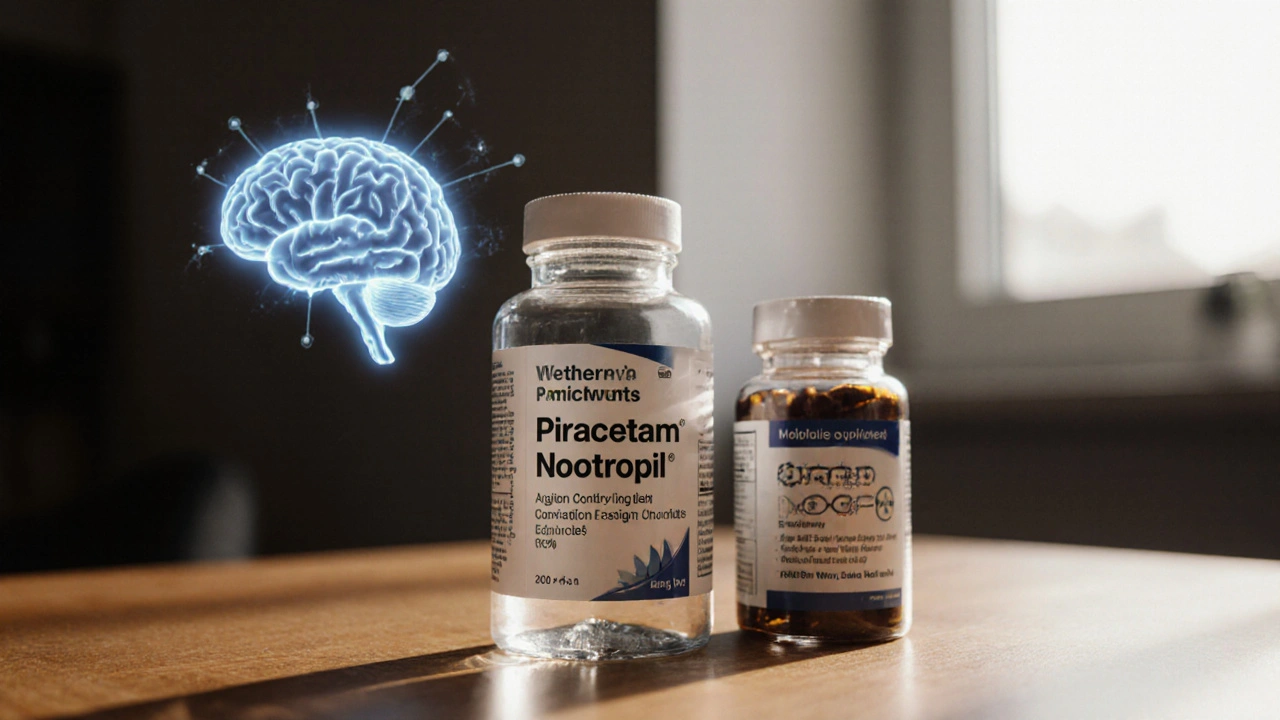Nootropic Comparison Tool
Select two nootropics to compare their attributes:
Piracetam is a racetam‑class cognitive enhancer that improves membrane fluidity, boosts acetylcholine activity, and supports short‑term memory formation. Marketed as Nootropil in many countries, it’s often the first name that pops up when people search for smart‑drug options. Yet the nootropics market has exploded with newer racetams and complementary compounds that promise sharper focus, deeper learning, or milder side‑effects. This guide cuts through the hype, compares the science, and helps you decide which supplement fits your brain‑boosting goals.
- TL;DR
- Piracetam is the original racetam; it works best for memory and learning speed.
- Aniracetam adds anxiety‑reduction and mood‑lifting effects.
- Oxiracetam is the go‑to for alertness and concentration.
- Pramiracetam offers the longest half‑life, useful for sustained study sessions.
- Noopept is a peptide‑like nootropic that’s much stronger per milligram but can be harsher on the stomach.
- Combining a racetam with a choline source such as Alpha‑GPC or L‑Theanine often smooths out headaches.
- Safety profiles are generally good, but individual tolerance varies; start low and monitor.
How Piracetam Works - The Science Behind the Original
Piracetam modulates the AMPA‑type glutamate receptors, enhancing synaptic transmission. It also improves the fluidity of the neuronal cell membrane, which helps ions move more freely and supports neuroplasticity. Clinical trials from the 1970s and 2000s show modest gains in verbal learning and recall, especially in older adults with age‑related cognitive decline. The drug is water‑soluble, has a short half‑life of about 4‑5hours, and is typically dosed at 1,200‑4,800mg per day split into two or three doses.
Key Alternatives - What’s New on the Shelf?
Beyond Piracetam, several newer racetams and non‑racetam boosters have entered the market. Each targets slightly different brain pathways, which translates into varied user experiences.
Aniracetam is a fat‑soluble racetam that enhances AMPA receptor activity even more than Piracetam and also modulates serotonin receptors, giving it mood‑lifting properties. Oxiracetam is a hydrophilic racetam noted for boosting high‑frequency brain waves, which translates to heightened alertness and focus. Pramiracetam is a high‑potency racetam with a long half‑life (up to 6hours) that primarily amplifies high‑affinity choline uptake. Noopept is a peptide‑like nootropic that mimics some racetam effects but is 1,000‑times more potent, acting on NGF and BDNF pathways. Alpha‑GPC is a choline donor that raises acetyl‑choline levels, often paired with racetams to prevent headaches. L‑Theanine is an amino acid from tea that promotes alpha‑brain waves and smooths the jittery edge of stimulatory nootropics.Side‑by‑Side Comparison
| Compound | Primary benefit | Half‑life | Typical dose | Notable side‑effects |
|---|---|---|---|---|
| Piracetam | Memory & learning speed | 4‑5h | 1,200‑4,800mg/day | Headaches (if choline low) |
| Aniracetam | Mood & anxiety reduction | 2‑3h | 750‑1,500mg/day | Rare GI upset, insomnia at high dose |
| Oxiracetam | Alertness & focus | 8‑10h | 800‑2,400mg/day | Restlessness, slight insomnia |
| Pramiracetam | Sustained attention | 5‑6h | 300‑1,200mg/day | Headaches, occasional dizziness |
| Noopept | Neuroprotection & rapid cognition | 1‑2h | 10‑30mg/day | Stomach irritation, vivid dreams |
Clinical Evidence - What the Studies Say
Large‑scale double‑blind trials on Piracetam date back to the 1970s, showing a 10‑15% improvement in word‑list recall among elderly participants. More recent meta‑analyses for Aniracetam report modest anxiety‑reduction scores comparable to low‑dose benzodiazepines but without dependence risk. Oxiracetam’s most robust data come from stroke‑recovery cohorts, where patients experienced faster gains in processing speed. Pramiracetam has limited human data; most evidence is anecdotal from students citing better retention over marathon study sessions. Noopept, though newer, shows neuroprotective effects in rodent models through increased BDNF expression, but human trials are still small.
Bottom line: Piracetam remains the most rigorously studied, but each alternative brings a niche advantage backed by at least some clinical or pre‑clinical data.

Safety, Tolerability & Legal Status
All the compounds listed are non‑prescription in most of Europe and Asia, but the UnitedStates classifies many racetams as “research chemicals.” This means they’re legally sold but not approved as dietary supplements. Side‑effects are generally mild: headaches (often fixed by adding a choline source), mild insomnia, or gastrointestinal discomfort. Rarely, users report increased irritability or vivid dreams, especially with Noopept.
Because the liver metabolizes racetams via cytochrome P450 enzymes, concurrent use with strong CYP inhibitors (e.g., grapefruit juice, certain antifungals) may raise blood levels. Pregnant or nursing women should avoid them entirely, as safety data are lacking.
Stacking Strategies - Pairing Racetams with Choline Sources
Headaches are the most common complaint when a racetam is taken without enough acetyl‑choline. Adding a choline donor eliminates that issue and often amplifies the cognitive boost. Alpha‑GPC (300‑600mg/day) or Citicoline (250‑500mg/day) are the preferred choices because they cross the blood‑brain barrier efficiently. For users who also need a calm focus, a small dose of L‑Theanine (100‑200mg) can smooth out the stimulant‑like edge of Oxiracetam while preserving alertness.
A typical “focus stack” for a university student might look like:
- Morning: 800mg Oxiracetam + 300mg Alpha‑GPC + 100mg L‑Theanine.
- Afternoon: 300mg Pramiracetam + 300mg Alpha‑GPC.
- Evening (optional): 10mg Noopept + 200mg L‑Theanine for recovery.
Adjust dosages based on personal sensitivity and always start at the low end.
Choosing the Right Nootropic for Your Goal
Think of each compound as a tool in a toolbox. Match the tool to the job:
- Memory & learning speed: Piracetam or Pramiracetam for long‑term retention.
- Focus & alertness: Oxiracetam plus choline.
- Stress relief & mood lift: Aniracetam with a modest L‑Theanine dose.
- Neuroprotection & rapid cognition: Noopept, but keep the dose low.
When you’re unsure, start with a low dose of Piracetam (800mg split twice daily) and add 250mg Alpha‑GPC. Observe how you feel for a week, then experiment with a second racetam if you need a specific effect.
Related Concepts & Next Steps
Understanding how these compounds fit into the broader landscape of cognitive enhancers helps you make better choices. Key related topics include:
- Neurotransmitter modulation: acetylcholine, glutamate, dopamine pathways.
- Blood‑brain barrier permeability: why some racetams are water‑soluble while others are fat‑soluble.
- Sleep and cognition: how nootropics interact with circadian rhythms.
- Regulatory environment: differences between EU, US, and Asian guidelines.
After reading this guide, you might want to explore deeper into “racetam pharmacokinetics,” “nootropic safety monitoring,” or “personalized brain‑health protocols.” Those topics form the next tier of the cognitive‑enhancement knowledge cluster.
Frequently Asked Questions
Is Piracetam safe for long‑term use?
Long‑term safety data are limited, but dozens of studies lasting up to 12months report no serious adverse events when dosed within recommended ranges. Most users tolerate daily use without major issues, especially when paired with a choline source.
Do I need a prescription for any of these nootropics?
In the UnitedStates, racetams (including Piracetam, Aniracetam, Oxiracetam, Pramiracetam) are sold as research chemicals and are not FDA‑approved dietary supplements. Europe and many Asian countries allow over‑the‑counter sale, but prescriptions may be required for medical use in some regions.
What dose of Alpha‑GPC should I use with a racetam?
Typical dosing is 300‑600mg per day, split into two doses if you’re taking multiple racetams. This amount reliably raises brain acetyl‑choline and prevents the classic “racetam headache.”
Can I combine more than one racetam at the same time?
Yes, stacking racetams is common, but start low and add them one at a time. A popular combo is Oxiracetam + Aniracetam for both focus and mood, but watch for cumulative side‑effects and adjust choline accordingly.
Is Noopept really 1,000 times stronger than Piracetam?
Potency refers to the amount needed for a measurable effect, not safety. Noopept works at 10‑30mg versus 1,200‑4,800mg for Piracetam, but its side‑effect profile can be harsher, especially on the stomach. Start at the lowest dose and increase only if tolerated.








I tried piracetam for a week and got zero results 😅 but then I added alpha-GPC and wow-my brain felt like it finally upgraded from dial-up to fiber. Seriously, don't skip the choline.
why do people spend so much time on this stuff when coffee works better and costs less? 🤡
I've been using aniracetam for anxiety for months now. It doesn't make me feel wired like stimulants do-just calmer, clearer. Not a magic pill, but it's become part of my routine. 🌿
Pramiracetam is the real MVP for long study sessions, but you gotta pair it with choline or your head will feel like a balloon full of nails. Also, noopept? Don't even start unless you like stomach cramps and weird dreams. I speak from experience.
In India, these are sold as 'brain tonics' at local pharmacies with zero regulation. I've seen people take 5000mg of piracetam daily and wonder why they're jittery. Start low. Seriously. Your liver will thank you. 💪
I’ve experimented with almost all of these over the past two years-piracetam, aniracetam, oxiracetam, noopept, pramiracetam, you name it. What I’ve learned is that the real difference isn’t the compound-it’s your baseline brain chemistry. Some people feel nothing, others get a 30% productivity boost. It’s not universal. And yes, choline is non-negotiable. I’ve been taking 600mg of Alpha-GPC daily for a year now, no headaches, just steady focus. Also, L-theanine with oxiracetam? Absolute game-changer. No more jittery hands during coding marathons. Honestly, if you’re going to do this, do it right. Don’t just throw pills at your brain like it’s a video game power-up.
I’ve been using piracetam for a year now. No side effects, just better recall on names and details. It’s not flashy, but it’s consistent. The real win? I stopped forgetting where I put my keys.
Oh great. Another ‘biohacker’ guide that reads like a pharmaceutical sales pitch. You’re all just trying to chemically optimize your way out of poor sleep, bad diet, and chronic distraction. Cool. Keep spending your money on ‘research chemicals’ while your cortisol levels are through the roof.
You people are pathetic. You think a pill fixes your inability to focus? You don't need noopept. You need to delete TikTok. You need to go outside. You need to sleep more than 5 hours. This isn't science. It's digital placebo worship.
America is falling apart because people like you think you can buy a smarter brain at the supplement store. Real intelligence comes from discipline, not racetams. You're all just trying to shortcut your way out of effort. Pathetic. 🇺🇸
I started with piracetam because my brain felt foggy after Zoom calls all day. Added choline and L-theanine and now I feel like I can actually think again 😊 I’m not trying to be a genius-just not exhausted all the time.
I've read through this twice. It's well-structured. The comparison table is especially helpful. I appreciate that you included half-lives and side effects-not just the hype. Most guides skip the downsides.
You misspelled 'pharmacokinetics' in the 'Related Concepts' section. Also, 'UnitedStates' is missing a space. These aren't minor errors-they undermine credibility.
My go-to stack: 800mg oxiracetam + 300mg alpha-GPC + 150mg L-theanine. Been doing this for 8 months. My productivity is up 40%. No crashes. No headaches. Just steady, calm focus. 🙌
Fascinating. The pharmacokinetic profiles of these compounds are remarkably divergent, yet the clinical literature remains fragmented. One must consider not only receptor affinity but also BBB permeability, hepatic metabolism, and individual polymorphisms in CYP enzymes. A truly nuanced approach is required. 🧠
i tried noopept once and my stomach felt like it was on fire 😅 but the focus was insane for like 2 hours. i wont do it again though. piracetam + choline is my chill vibe now